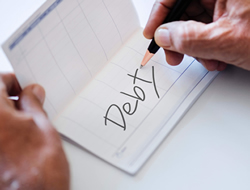Casey Bond* says the difference between good and bad debt comes down to whether you are creating future opportunities or future problems.
 The average total debt per household in Australia is a whopping $168,600, according to the Australian Bureau of Statistics (ABS).
The average total debt per household in Australia is a whopping $168,600, according to the Australian Bureau of Statistics (ABS).
That might seem pretty troubling, but some debtors would be quick to point out that not all their debt is bad.
How is that possible?
There is a difference between good debt and bad debt, according to Jennifer B. Harper, the owner of Bridge Financial Planning.
“The way to determine which is which is to consider whether or not the debt is creating a future opportunity or a future problem,” she explained.
So do you have good debt? Or bad debt? Here’s how to know.
What it means to have good debt
Debt is not inherently good or bad.
But in general, most financial experts agree that taking on certain types of debt can lead to better outcomes than others.
In that sense, you can say that some debt is considered good — when used the right way.
“In general, debt can make sense when it is targeted toward an investment in yourself, an opportunity to increase earning power or using that leverage to purchase an appreciating asset,” said financial planner Jeff Burke.
Here are some examples of good debt.
Mortgage:
Not many people are able to purchase a house for cash.
Usually, homebuyers have to take on some debt to own property.
“Homes are usually appreciating assets and can also provide certain tax benefits,” Burke said.
“These benefits can far outweigh the downside of not having the debt but paying rent and not building equity.”
Of course, if you overextend yourself and borrow too much or purchase a home you can’t afford to maintain, that debt isn’t good at all.
Car loan:
Taking out a loan to buy a newer or fancier car than you can afford with cash is definitely not a good thing.
But if borrowing a bit of money to buy a car means opening up other financial opportunities, it can be considered good debt.
“For example, if you need a car to get to a job to earn money, it’s OK to have a small loan on a used car,” Harper said.
“You’re creating future opportunities for yourself.”
“However, a car loan can be bad debt too, if high payments, insurance and maintenance expenses are keeping you from enjoying other areas of your life.”
Credit-building debt:
The unfortunate reality of the credit industry is that every adult has to take on some form of debt in order to build a good credit score.
If you don’t begin building a strong credit history and score early in life, it can be tough to borrow money at an affordable rate later.
Plus, good credit is needed for general life needs like renting and getting a mobile phone plan.
Often, the easiest way to build credit is to open a credit card and use it regularly.
However, that doesn’t mean you have to carry a balance or incur interest charges for your credit score to grow.
“The plan should be to only charge an amount that you could have paid cash for and plan on paying the full amount each month,” Burke said.
In that sense, credit card debt can be good, since it helps you build credit ― but only if it’s debt that you pay off each month.
The concept of good debt can be a slippery slope for people who use it to rationalise their borrowing and end up getting in over their heads.
“Anyone taking on debt still needs to understand how much debt they can afford,” Burke said.
And he warned against letting lenders or brokers tell you how much that is.
You should crunch the numbers on your own and know how much of your monthly budget can really be taken up by debt payments.
Then decide if that debt is really going to leave you in a better place than you are now.
What is considered bad debt?
Whereas good debt offers potential benefits down the road, bad debt won’t leave you better off.
Debt incurred for lifestyle or consumer expenses you can’t afford is bad debt.
For example, if you charge purchases for clothes, entertainment, dining out or furniture to a credit card and then carry a balance month over month, you’ll accumulate interest and possibly go deeper into debt.
Meanwhile, those new outfits and fancy meals aren’t doing anything to increase your bottom line.
Credit card debt isn’t the only bad form.
There are also payday loans, tax debts, medical debts and any other debt that will cost you money in the long run.
“Credit cards and payday loans are always a bad deal,” Harper said.
“They create future problems.”
Living the debt-free life
Even though some types of debt are better than others, if you have the choice between going into debt and not, choose the debt-free option.
There are financial and psychological benefits to living without debt payments looming over your head.
“The flexibility that comes with not having a chunk of your income dedicated to fixed payments allows you to have more options with your income,” Burke said.
Plus, there’s something to be said for the peace of mind that comes from knowing you don’t owe anyone money.
Ultimately, debt can be a tool that helps you access other opportunities, but it’s never guaranteed, so borrow wisely.
* Casey Bond is Money, Home and Living Reporter for The Huffington Post.
This article first appeared at www.huffingtonpost.com.au.











